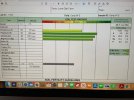Hello, I'm looking for some input on how to handle and imbalance that showed up in my soil test. For each of my plots, whether they be clover seedings or oat/turnip combo's are coming back as "Very High" P content and "Low" K.
1) can the "Very High" P content stunt growth?
2) At planting last year we used 15-15-15, so it appears that K uptake is more drastic than P
3) I know the solution here could be a custom fertilizer, but in the past, i have been unable to find it for the smaller quantities I need.
4) Am I better off to put down no K and no P or continue to use fertilizer that has them both in equal amounts.
If it matters I went through the university of KY extension service as they offer free testing so I am pulling my terms straight from their form.
I'm sure I'm leaving out info that might be helpful, so please let me know what additional is needed.
1) can the "Very High" P content stunt growth?
2) At planting last year we used 15-15-15, so it appears that K uptake is more drastic than P
3) I know the solution here could be a custom fertilizer, but in the past, i have been unable to find it for the smaller quantities I need.
4) Am I better off to put down no K and no P or continue to use fertilizer that has them both in equal amounts.
If it matters I went through the university of KY extension service as they offer free testing so I am pulling my terms straight from their form.
I'm sure I'm leaving out info that might be helpful, so please let me know what additional is needed.



